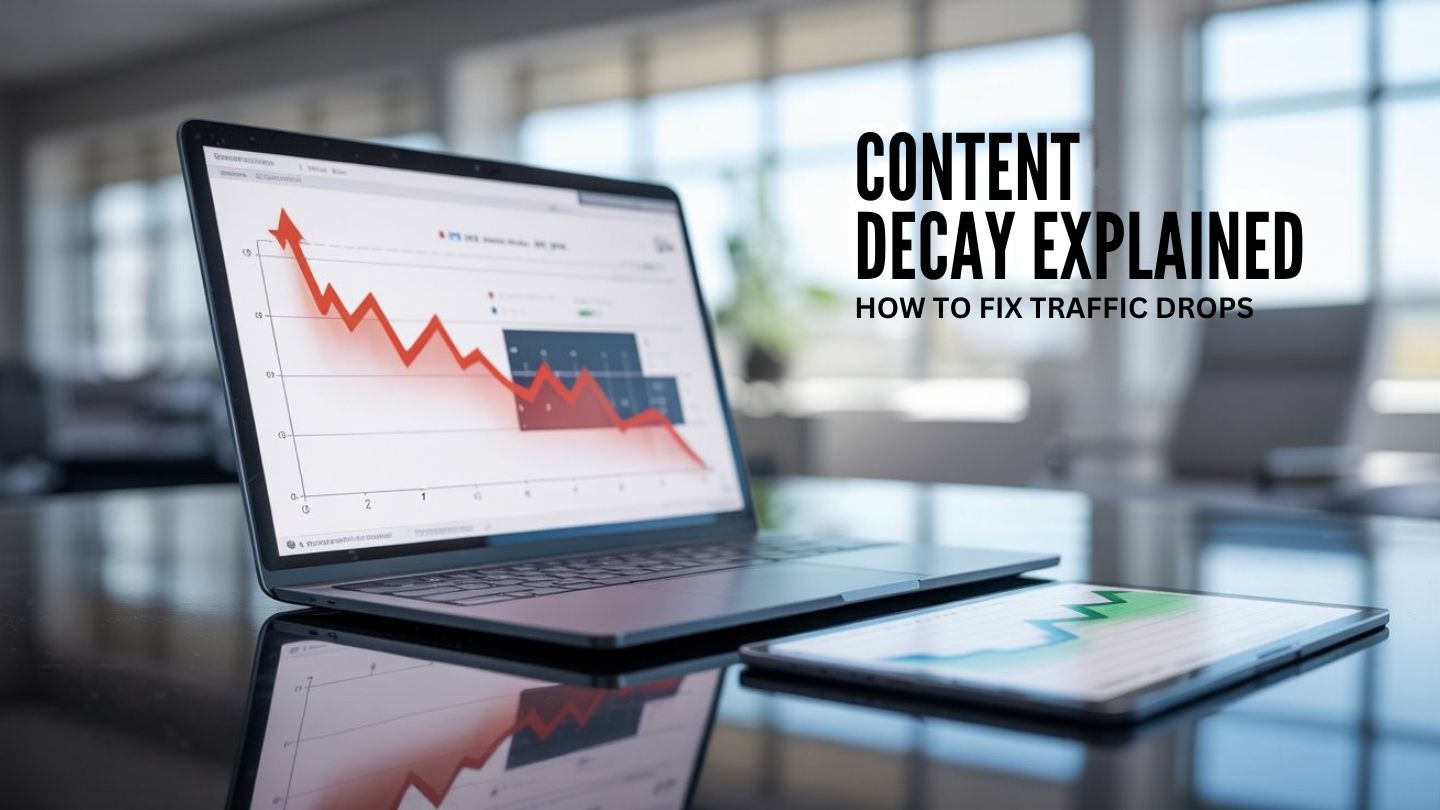
In the fast-moving world of digital marketing, even the most successful blog posts can lose their edge over time. If your once high-performing pages are now seeing a gradual dip in visitors, you’re likely facing a silent but solvable challenge called content decay. Understanding what causes it — and knowing how to fix it — can help restore your organic traffic and keep your brand visible in competitive search results.
What Is Content Decay?
Content decay refers to the slow decline in a page’s organic traffic, rankings, and engagement over time. This typically happens when your content becomes outdated, less relevant, or overshadowed by fresher competitors.
Search engines like Google continuously re-evaluate which pages best satisfy a user’s intent. So, if newer articles provide more current data, clearer insights, or stronger on-page optimization, your previously top-ranking content can slip down the results page.
This natural aging process doesn’t mean your content failed — it simply means your competitors and search algorithms have evolved, and your content must evolve too.
Why Content Decay Happens
Content decay can creep in for several reasons, often hidden behind subtle shifts in the search ecosystem:
- Algorithm Updates: Google frequently adjusts how it ranks content. Pages that once aligned perfectly with ranking factors might no longer meet modern expectations. The Google content ranking insights explain how updates affect visibility and what businesses should monitor.
- Search Intent Shifts: User expectations evolve. What your audience wanted two years ago might differ today — meaning your content could be answering yesterday’s questions.
- Competitor Refreshes: When other websites update or republish their pages with fresher examples or recent statistics, Google sees them as more authoritative.
- Technical and Crawling Issues: If your content isn’t being re-crawled efficiently, even updates may go unnoticed. Learn how to ensure your high-quality content is crawled by Google to avoid this problem.
- Lack of Engagement or Backlinks: Declining user interaction and fewer new backlinks can signal to search engines that your content no longer deserves top placement.
The Business Impact of Content Decay
Ignoring content decay can cost more than rankings — it can affect your sales pipeline, brand authority, and marketing ROI.
When traffic drops, fewer leads find their way to your landing pages, and your domain’s topical authority weakens. Over time, this can erode your brand’s online visibility, making it harder for even new content to perform.
However, identifying and fixing decayed pages is a low-cost, high-return SEO strategy. Instead of producing new blogs from scratch, you can refresh and optimize existing ones for faster recovery and long-term sustainability.
How to Identify Content Decay
Before you fix content decay, you need to spot it. Here’s how:
- Use Analytics Tools: Compare historical traffic data in Google Analytics or Search Console to find steady declines over several months.
- Check Ranking Movements: Use an SEO tool to see which keywords lost visibility.
- Audit Click-Through Rates (CTR): If impressions stay steady but clicks drop, your meta titles or descriptions may no longer attract users.
- Review Content Freshness: Check publication dates and factual accuracy. Outdated references or broken links often signal decay.
By performing a quarterly content audit, you can proactively catch these trends before they impact your overall organic traffic.
How to Fix and Prevent Content Decay
Recovering from content decay isn’t about rewriting everything — it’s about strategic optimization. Follow these proven methods to revive your traffic:
1. Refresh Data and Examples
Update old statistics, quotes, or screenshots with current references. Replace outdated studies with new insights to maintain credibility.
2. Enhance Search Relevance
Review your target keywords and search intent alignment. Google’s query processing continues to improve, meaning relevance is key. Google’s on query processing and content ranking explores how to align your content with modern algorithms.
3. Improve User Experience
Boost readability with shorter paragraphs, descriptive headers, and visuals. A positive user experience reduces bounce rates and encourages longer engagement.
4. Add Depth and Context
Broaden your coverage of a topic. Include subtopics, FAQs, or examples that give users more value. Even adding user-generated content, such as testimonials or comments, can help. Discover how user-generated content can boost SEO and support long-term ranking success.
5. Reoptimize Internal Links
Strengthen internal linking structures so decayed pages regain authority from stronger URLs.
6. Promote Updated Content
Once you’ve refreshed an article, share it again across your marketing channels. Google often re-evaluates republished pages faster when they receive renewed engagement.
7. Invest in Professional Copy Updates
If you manage large volumes of web pages, consider hiring experts to handle rewrites strategically. Partnering with a specialized content writing service ensures that your updates are both SEO-aligned and brand-consistent.
Long-Term Strategies to Prevent Future Decay
To prevent content decay from resurfacing, implement an evergreen content maintenance plan:
- Create a content calendar that includes scheduled updates for key articles every 6–12 months.
- Track keyword volatility to stay ahead of search intent changes.
- Encourage engagement signals like comments, shares, and backlinks.
- Use structured data and schema markup for better SERP visibility.
Consistency in auditing and updating ensures your content portfolio remains robust against algorithm shifts and changing audience behavior.
Conclusion: Keep Your Content Alive and Performing
Content decay is inevitable — but traffic loss doesn’t have to be. By auditing your website regularly, updating older content with new insights, and ensuring technical SEO health, you can maintain sustainable growth and authority.
At the ocean marketing, we help businesses strengthen their online visibility through strategic content management, SEO analysis, and professional copy refreshes. If you’re noticing traffic drops or ranking declines, it might be time to act. Contact us today to revitalize your content and keep your brand ahead in the digital race.

Marcus D began his digital marketing career in 2009, specializing in SEO and online visibility. He has helped over 3,000 websites boost traffic and rankings through SEO, web design, content, and PPC strategies. At The Ocean Marketing, he continues to use his expertise to drive measurable growth for businesses.

